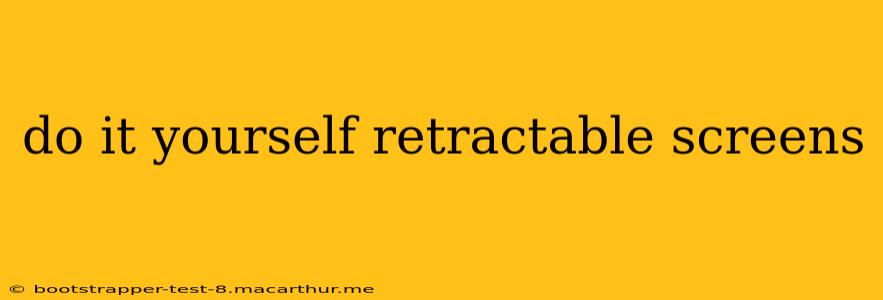Retractable screens offer a stylish and practical solution for controlling sunlight, privacy, and insects. While professionally installed screens are an option, many homeowners find the DIY route appealing – offering cost savings and a rewarding sense of accomplishment. This guide provides a comprehensive walkthrough for installing your own retractable screens, addressing common questions and concerns along the way.
What are the Different Types of DIY Retractable Screens?
Several retractable screen types cater to various needs and budgets. Understanding these differences is crucial before embarking on your DIY project.
- Roller Screens: These are the most common type, utilizing a spring-loaded mechanism to roll the screen up into a cassette. They're relatively easy to install and offer a clean, streamlined look.
- Sliding Screens: These screens slide horizontally within a track system. Ideal for larger openings or areas requiring more flexible screen control. They often require more precise installation than roller screens.
- Zip Screens: These screens utilize a zip track system, securing the screen tightly to the frame and preventing flapping in windy conditions. They are typically more durable and expensive but offer superior wind resistance.
How Difficult is it to Install Retractable Screens Yourself?
The difficulty of installing retractable screens yourself depends significantly on the type of screen and your experience with DIY projects. Roller screens are generally considered the easiest to install, while sliding and zip screens require more precision and potentially specialized tools. A basic understanding of carpentry and measuring is helpful, but detailed instructions often come with the kit. If you're comfortable with basic home improvement tasks, you should be able to handle the installation.
What Tools and Materials Will I Need?
The specific tools and materials needed will vary based on the type of retractable screen you choose and the installation location. However, a common list includes:
- Measuring Tape: Crucial for accurate measurements to ensure a proper fit.
- Drill: Essential for mounting the screen casing and brackets.
- Screwdriver: For fastening screws and brackets.
- Level: Guarantees a straight and even installation.
- Pencil: For marking drilling points and cutting lines.
- Safety Glasses and Gloves: To protect yourself during the installation process.
- Retractable Screen Kit: This includes the screen material, casing, brackets, and all necessary hardware.
What are the Different Types of Retractable Screen Cassettes?
Retractable screens come in various cassette styles, each affecting the overall aesthetic and sometimes functionality.
- Round Cassette: This is a classic and widely popular design, blending seamlessly with many home styles.
- Square Cassette: Offering a more modern and minimalist look.
- Flat Cassette: A slim and low-profile design ideal for those seeking a less visually prominent solution.
- Recessed Cassette: Designed for installation within a frame or recess, minimizing its overall appearance.
Can I Install a Retractable Screen on a Window That Already Has a Screen?
Yes, you can typically install a retractable screen over an existing screen. However, this may require some modifications to ensure proper fit and functionality. You might need to remove the existing screen or adjust the window frame to accommodate the new retractable screen. Careful planning and measurements are crucial in this scenario.
How Much Does it Cost to Install DIY Retractable Screens?
The cost of installing DIY retractable screens varies greatly depending on the size of the screen, type of screen, and the quality of the materials. However, you can generally expect to save a significant amount compared to professional installation. Factor in the cost of the screen kit, any additional tools you may need, and the time you invest in the project.
Choosing the Right Screen Material: What's Available?
Retractable screens offer a range of material choices, each affecting durability, light transmission, and privacy.
- Fiberglass: A durable and affordable option offering good resistance to tears and stretching.
- Polyester: Often blended with other materials for enhanced strength and UV resistance.
- Solar Screen: Designed to block sunlight and reduce heat gain.
- Mesh: Provides excellent ventilation while maintaining insect protection.
By carefully considering these factors and following the manufacturer's instructions, you can successfully install your own retractable screens, enhancing your home's comfort and aesthetics. Remember, safety is paramount; always prioritize proper measurements, secure mounting, and the use of appropriate safety equipment.
